This updated standard operating procedure (SOP) revises the guidance issued in the April 4, 2013, Postal Bulletin (PB 22360, page 10) that addresses the updated hyperlink for label printing and shipment to Atlanta, Georgia.
The purpose of this Standard Operating Procedure (SOP) is to establish processes for handling and recycling dry-cell rechargeable and nonrechargeable batteries through the Mail Recovery Center (MRC) in Atlanta, in accordance with Postal Service™ policies and universal waste-management regulations. Federal environmental regulations require that all universal waste be recycled. This SOP establishes methods for recycling small dry-cell batteries at all Postal Service operations and requires all employees to follow approved disposal and recycling procedures for used batteries.
Certain types of batteries are considered hazardous because they contain heavy metals or corrosive electrolyte solutions. These include (but are not limited to) nickel-cadmium (Ni-Cd), nickel-metal hydride (NiMH), lithium (LI) or lithium ion (Li-ion), lithium polymer (Li-poly), silver oxide, and other small dry-cell batteries. When these batteries die, they must be handled as universal waste.
Universal waste is a subcategory of hazardous waste but is subject to less restrictive environmental regulations, as long as the universal waste is scheduled for recycling. Lead-acid automotive batteries and sealed lead-acid emergency batteries are designated as universal waste, but are not discussed in these instructions.
The pictures below show common types of batteries:
n Ni-Cd and NiMH batteries are used in cell phones, pagers, cameras, and power tools.
n Li-ion batteries are used in some cell phones, laptops, and cameras, and in all Intelligent Mail Data Acquisition System scanners.
n Li batteries are used in cameras and other electronic devices that don’t require rechargeable batteries.
n Silver oxide batteries are used in watches, laptops, and other devices that require button-cell batteries.
Approximately 70 percent of the batteries used by the Postal Service are rechargeable, and a majority of these are Ni-Cd, Li-ion (secondary lithium), and sealed lead-acid.
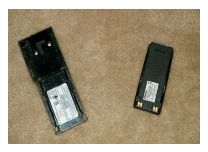
Walkie-Talkie/Cell Phone
Nickel Metal Hydride
Nickel-Cadmium
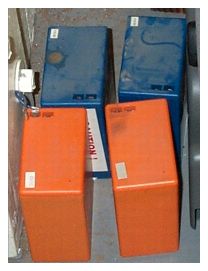
Emergency Lighting
Small sealed lead-acid

Power Tools
Nickel Metal Hydride
Nickel-Cadmium

IMDAS Lirhium Ion
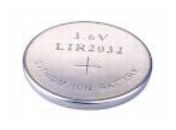
Lithium Ion Button Batteries
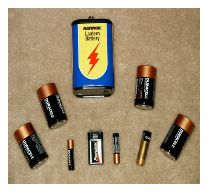
Alkaline/Dry-Cell
A, AA, AAA, C, D cell batteries
9-volt and lantern batteries
When an inoperable battery is removed from a piece of equipment, determine what type it is and follow the management guidelines for disposing of it. There are three primary types of batteries, each with specific handling requirements:
n Alkaline batteries — considered nonhazardous.
n Sealed lead-acid batteries — not covered in this document.
n All other dry-cell batteries — handle as universal waste.
Except for Li-ion IMDAS batteries, which have specific mailing requirements, alkaline batteries and small dry-cell batteries should be recycled according to the shipping procedures outlined in this article. For Li-ion battery shipping instructions, including the requirement that no more than three Li-ion rechargeable batteries should be mailed together, see Mailing Standards of the United States Postal Service, Domestic Mail Manual (DMM®).
Batteries greater than 9 volts (e.g.12-volt, 14-volt, 16-volt, 18-volt, and 24-volt) or with different chemistries follow the shipping procedures outlined in this article with one exception — they must not be combined with mixed batteries of less than or equal to 9-volt batteries. Voltage batteries larger than 9-volts of the same type must be packaged and shipped separately from smaller mixed batteries.
1. Select a small, sturdy cardboard box. If opting for a used box, remove or cover all barcodes.
2. Place up to 15 pounds of dry-cell batteries into the box and pack them securely with paper. To prevent short circuits, tape all battery terminals so they don’t have contact with one another.
3. Tape the box shut.
4. Print the following address label from the following link: https://www.uspsreturns.com/CreateLabel.aspx?ID=103&DisplayType=Customer&ShippingInfoIncluded=No
a. You will be instructed to enter your facility address.
b. For Package & Shipping Information enter Small Dry Cell Batteries.
c. Click next and follow printing instructions.
5. Do not use Priority or Express Mail Tape or Priority or Express Mail Boxes.
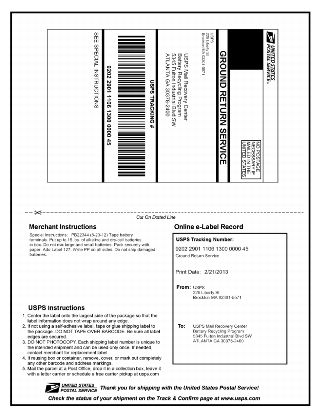
 Never Ship Damaged Batteries. Batteries that are leaking, burned, cracked, melted, or otherwise damaged must be recycled locally.
Never Ship Damaged Batteries. Batteries that are leaking, burned, cracked, melted, or otherwise damaged must be recycled locally.
Keep records of the batteries you send to the MRC. A sample record-keeping table is shown below:
Contact the Office of Sustainability with any questions about onsite, universal waste-management procedures. Guidance on proper battery storage and labeling can be found on the Office of Sustainability website at http://blue.usps.gov/sustainability/.
— Corporate Sustainability Initiatives,
Office of Sustainability, 5-30-13
